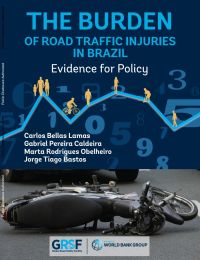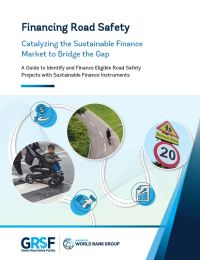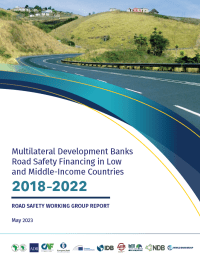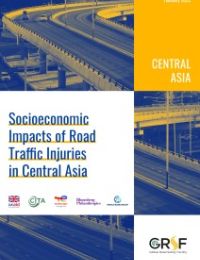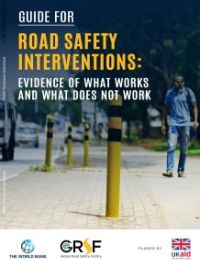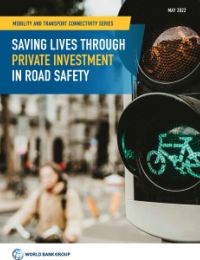Publications
1-8 of 8
-
-
Economics & Finance
Journal Article - The Value of a Statistical Life in the Context of Road Safety: A New Value Transfer Approach
May 2025
-
Economics & Finance
Financing Road Safety: Catalyzing the Sustainable Finance Market to Bridge the Gap
February 2025
-
Economics & Finance
Multilateral Development Banks Road Safety Financing in Low and Middle-Income Countries: 2018–2022
May 2023
-
-
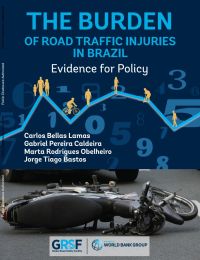
This study evaluates injuries, disabilities, deaths, and associated costs resulting from traffic crashes in Brazil, while suggesting policies to reduce long-term disability and societal impact. In addition to estimating the costs associated with RTIs, the study also addresses factors within the transport system that have an effect on road safety in Brazil, and incorporates these insights into policy recommendations aimed at reversing the cycle of dangerous road crashes.
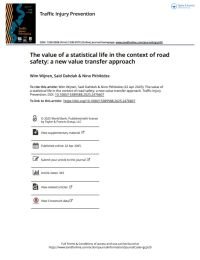
Objective: The value of a statistical life (VSL) is a key input for cost-benefit analysis (CBA) in the context of road safety and for calculations of the socio-economic costs of road crashes. However, many countries, especially low- and middle-income countries (LMIC), lack country-specific VSL estimates. To address this, value transfer is often used, where VSL estimates from other countries are adapted to local situations to estimate the VSL in the countries with no VSL estimates. This paper presents new guidance for VSL value transfer in the context of road safety.
Method: A unit value transfer approach is applied, which implies that a base VSL is determined and used to estimate the VSL in other countries. We collected VSL estimates from 32 countries worldwide to determine base VSLs for both high-income countries (HIC) and LMIC. According to the literature, the VSL is strongly correlated with income per capita. Therefore, income elasticities from the literature are applied to account for the impact of per capita income on the VSL.
Results: The resulting VSL transfer functions are VSL = 0.404*(Y/5,726)1.2 for LMIC and VSL = 3.206*(Y/42,087)0.8 for HIC, where VSL is the VSL in million USD and Y is the Gross National Income per capita (USD, 2020 prices). The VSL ranges from approximately 22,000 USD to 1.1 million USD in LMIC and from 1.2 million USD to 4.8 million USD in HIC.
Conclusions: We recommend applying this VSL transfer approach for cost-benefit analysis and road crash costing in countries lacking appropriate country-specific VSL. Moreover, this study highlights that, despite the growing interest in LMIC in research on VSL, the number of studies in these countries is still limited, emphasizing the need for more VSL studies. Finally, developing transfer functions for non-fatal injuries is recommended, which is an essential input for CBA as well.
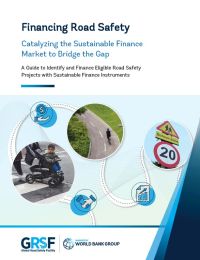
The burden of road traffic injuries is a significant global challenge requiring urgent attention and investment. By integrating road safety investments with broader development goals and leveraging innovative financing solutions such as labeled sustainable bonds and loans, available financing for road safety projects can be dramatically increased.
The societal, economic, and human benefits of improving road safety are extensive, making it a critical priority for national agendas. Through strategic investments in road safety, economic burdens can be mitigated, long-term growth promoted, and a safer, more equitable world created for all.
The multilateral development banks -- together with the Global Road Safety Facility and with strong donor support -- can help countries catalyze the sustainable finance market to fund high-impact and results-oriented road safety projects.
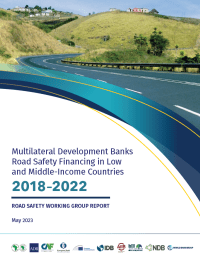
The Multilateral Development Banks (MDBs) Road Safety Working Group, established in 2009, is comprised of ten member institutions that are uniquely positioned to support countries in reaching their considerable and challenging road safety financing needs.
In early 2023, the working group reviewed progress made by the MDBs in financing road safety activities in low and middle-income countries (LMICs), and found that MDBs collectively committed $3.6 billion toward road safety initiatives in developing countries during the period 2018-2022. Three standalone road safety projects—in Bangladesh (World Bank), India (Asian Development Bank and World Bank), and Romania (European Investment Bank)—totaled $912 million in MDBs financing, which is more than one-quarter of the amount committed during this timeframe.
The review is based on details of road and urban mobility project financing provided by seven of the working group's ten members.
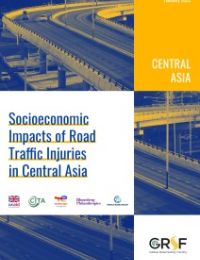
Road traffic injuries (RTIs) are well known to cause enormous human suffering in terms of both morbidity and mortality, and on a global scale. The economic dimension of the disease burden is far less well understood; but it is important to assess the size of the economic burden so that it can be considered when calculating the cost-benefit ratio of policies to tackle this problem. Because it is, in principle, and to some degree, an avoidable one.
This report focuses primarily on assessing various dimensions of the economic consequences of RTIs, as applied specifically to four Central Asian countries (Kazakhstan, Kyrgyzstan, Tajikistan, and Uzbekistan) – a part of the world in which there is still a major need to reduce RTIs.
This study shows that on top of the harm RTIs inflict upon human health, they also impose a considerable financial burden on health care systems. In 2016, the total estimated health costs of RTIs in these four countries was approximately Int$95 million, ranging from Int$2.8million in Tajikistan to Int$49.3 million in Kazakhstan. In Kazakhstan, the overall health costs resulting from RTIs were similar to the cumulative expenditure for rehabilitative and palliative care within the state-guaranteed basic package. The heavy financial burden on health care systems to manage RTIs in these countries adds weight to the urgency to increase preventive efforts by road safety policymakers, and should motivate appropriate organization of the post-crash response by health care system decision makers. The cost estimates discussed in this report indicate the potential for significant economic cost savings if both deaths and injuries from road crashes could be substantially reduced in these countries.

Road traffic crashes result in an estimated 1.35 million deaths and 50 million injuries worldwide per year with over 90 percent of these occurring in Low-Middle Income Countries (LMICs). Aside from the obvious pain and suffering this inflicts on individuals and communities, these deaths and injuries also place a large financial burden particularly on LMICs, by slowing economic growth.
The scale of the current response to this continuing crisis does not match the size of the problem. In addition, limited road safety resources are often expended on ineffective or suboptimal interventions. While road safety knowledge has improved over recent decades, there is still a need to improve decision making when selecting and applying effective evidence-based road safety interventions. Effective interventions are those that reduce fatal and serious injuries.
The World Bank's Global Road Safety Facility (GRSF) has developed this evidence-based guide on “What Works and What Does Not Work” in road safety in response to the critical need for effective evidence-based solutions.
This guide has been prepared to help readers understand that not all road safety interventions are equally effective and that what appear to be “common-sense” approaches to selecting road safety interventions will often not be the best. Although some provide benefits, others have very limited or even negative impacts, despite being commonly—and mistakenly—recommended or accepted. The guide offers a range of recommendations with a focus on interventions in LMICs, although the information may also be of relevance to all countries. The contents will be valuable to those working on road safety at policy or practitioner levels, including World Bank technical team leaders and others who seek to establish, expand, or improve road safety programs in LMICs.
The guide sets knowledge on evidence-based interventions within a “Safe System” context, providing advice on each of the Safe System pillars (road safety management, safe roads, safe speeds, safe vehicles, safe road users, and post-crash care) while recognizing that evidence-based solutions must be drawn from across pillars to produce effective road safety outcomes. At the core of this document is a summary table with an overview of beneficial and non-beneficial interventions based on sound scientific evidence. This is followed by more detailed information including case studies and references to the evidence base to support the summary.
Many safe road interventions are recommended for adoption, including integrated public transport, roadside and central barrier systems, medians, infrastructure to support appropriate operational speed for road users, roundabouts, grade separation and interventions to reduce exposure to risk at intersections, pedestrian footpaths and crossings, separated bicycle and motorcycle facilities, and traffic signs and line marking (including audio-tactile line marking). Some of these are highly effective, with up to a 70 or 80 percent reduction in fatalities and severe injuries (for example, safety barriers and roundabouts).
Various speed-related interventions also produce significant benefits, with some able to almost eliminate death and serious injury. Examples of effective speed interventions include traffic calming (including humps and chicanes), roundabouts, raised intersections and crossings, gateway treatments, lower speed limits (including 30 km/h (20 mph) zones for pedestrians) and speed cameras.
A variety of road user-based interventions have been implemented over many years, with effective examples including extensive supervised on-road practice and/or graduated licensing systems as part of the driver-licensing system, increased age for driving license eligibility, hazard perception training and testing, public education and campaigns as part of an integrated strategy (especially communicating enforcement to increase general deterrence), enforcement, penalties, alcohol interlocks, fatigue and speed monitoring, and increased helmet wearing rates.
Key vehicle-based interventions include applying minimum vehicle safety standards and vehicle ratings (through the Global New Car Assessment Program, or “NCAP”), seat belts, periodic vehicle maintenance, daytime running lights, under-run guards on trucks, Electronic Stability Control, and other advanced vehicle technologies.
Enhanced post-crash care can also produce better road safety outcomes, including systems to improve emergency response time, better emergency care, improved first aid skills for the public, and improved hospital care.
Equally important, the report also identifies clear examples where interventions are not effective. The worst of these are interventions that increase risk. These include increasing travel speed without improving quality of safety infrastructure, most forms of post-license driver and rider education and training, and many (but not all) forms of regular school-based driver education (such as those that seek to increase car-handling skills). The increase in risk is typically because such initiatives increase the level of confidence leading to an increase in risk taking. Other interventions that have no demonstrated safety benefits are to be avoided. These include license schemes through application or payment, training programs or education within schools that aim to improve road safety knowledge (including ad hoc visits by road safety experts or enthusiasts), and education campaigns conducted in isolation.
There are effective alternative interventions for each of these as described within this document, and these should be applied instead. It is extremely important that resources are not wasted on ineffective interventions on behalf of road safety but rather that evidence-based road safety interventions are employed.
There are a variety of documents available on the issue of road safety intervention effectiveness, many of which are referenced here. However, there are some key points of differences and added value in this guide, including a synthesis of the evidence on a broad range of interventions and a contrast between effective and noneffective interventions, allowing readers to compare options. Where noneffective interventions are identified, viable effective interventions are provided thereby supporting decision making. The guide also provides direct advice to those working in LMICs, drawing on key sources of information where this is available. Importantly, concise yet robust evidence is provided across each of the Safe System pillars.
There is a need to continue building the knowledge base on effective road safety interventions, particularly in LMICs where there are a number of gaps in knowledge. The contents of this guide represent a useful, up-to-date summary of current knowledge for application.
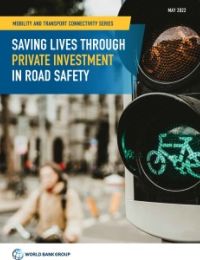
The World Bank estimates a significant funding gap in road safety of 260 billion to achieve SDG 3.6 and 11.2 in the next ten years, and recognizes that this gap cannot be closed through public funding alone and thus mobilization of private capital is required. The impacts of road traffic crashes reach far into the economy and can cost L/MICs as much as 6% of their GDP. The costs of a road traffic crash do not end at the roadside; they create ripple effects throughout the wider economy. Loss of income, property damage, insurance premiums, loss of taxes, and burdens on the health sector are just some of the far-reaching costs associated with road traffic crashes. Road traffic crashes can cost countries as much as 6 percent of their GDP and trap families in poverty as they lose income generating potential and focus on providing lifetime care.
This report examines the potential for private capital mobilization to close this gap. The report investigates the market failure to appropriately account for the cost of road crashes, which prevents private capital from flowing to road safety investments. The growth of socially responsible investing and the sustainable finance market offers a new opportunity to address this market failure. The report proposes different business models and financing instruments to channel private investment into road safety projects. These investment structures consist of subnational, public-private partnerships (PPPs) and corporate investments that can leverage the growing sustainable finance market, including social and sustainability-linked financings (SLFs).
The report also develops indicators that can be used to tie the cost of financing to the attainment of road safety targets, incentivizing borrowers to commit to road safety as part of SLFs. The report examines the enabling environment for structuring investable road safety projects in a sample of countries, looking at the barriers and opportunities, and proposing risks and mitigation strategies, like blended finance mechanisms and stable revenue sources, for long-term sustainability of road safety investments.

Based on 2018 findings of the World Health Organization (WHO), the number of deaths due to road crashes is 1.35 million deaths per year. While this number is quite high and increasing every year, the rate of road crash deaths per 100,000 of population has remained constant, at around 18 deaths, over the years. This rate of deaths is however not distributed proportionately amongst the different regions and countries. The high-income countries have recorded lowest average rate at 8.3 per 100,000. In contrast to this number, low-income countries have the highest annual road traffic fatality rates averaging at 27.5 deaths per 100,000– more than three times the average for high-income countries.
ROAD CRASH AND IMPACT
Most of the deaths and injuries from road crashes are of the working age population, which negatively impacts both the economy and the demography of the region. Road traffic injuries are currently the 8th leading cause for death for all age groups, and further compounding the demographic impact is the fact that road crashes are the leading cause of death for children and young adults, between the ages of 5 and 29 years.
Road traffic crashes have a high economic impact, costing 3 percent of a country’s GDP on average. They also cause a significant impact on the individuals as well as their families. Injuries arising due to road crashes can lead to trauma for the individual and loss in productivity. Along with costs of treatment, economic challenges may further be increased due to temporary or permanent loss of income as well. Along with the victim, road crashes take an emotional toll on the immediate family members and caregivers during the treatment process or any deaths and add to the economic burden as they may need to take time off work or school to care for the injured.
The distribution of road users varies within different regions and income groups of countries. This impacts the variations in death rates amongst the users. The low- and middle-income countries have a significantly high proportion of pedestrians, cyclists and two- or three-wheeler motorized vehicles. Overall, the global road traffic deaths for pedestrians and cyclists is at 26% and another 28% for two- and three-wheeler motorcyclists, totaling nearly 54% of vulnerable road users. This proportion varies in comparison between the economic group of countries, with a high percentage of road crash victims being car occupants.
Globally, a significant percentage of road crash victims being car occupants is also an indicator of insufficient infrastructure for controlling traffic speeds and volumes. Furthermore, when people use private cars more for their daily activities, it results in a higher level of total vehicle-kilometers traveled (VKT). Choice of using personal vehicle over using non-motorized transport or public mass transport may be attributed to the car-centric planning and design of road infrastructure. Many countries lack adequate protected infrastructure for pedestrians and cyclists. This discourages users to walk or bicycle to their destinations.
Mode-choice plays a critical role in road safety. Public mass transit systems not only provide faster and safer transportation mode choices, they also help reduce dependency on privately owned vehicles on the road. Public mass transit services typically follow designated routes as well, thereby minimizing interferences between different types of road users. While many countries still have to develop mass transit infrastructure such as metro rails, public bus system is quite prevalent, with bus rapid transit (BRT) and bus only lane infrastructures being developed. Absence of proper first and last mile connectivity to the transit stations poses security threats for road users and discourages them from using public transport.
SAFE SYSTEM APPROACH
The Safe System approach derives from the Swedish Vision Zero and Dutch Sustainable Safety strategies that have a long-term goal for a road traffic system to be eventually free from fatalities and serious injuries. It represents a shift away from traditional approach of preventing collisions to a more forgiving approach of preventing fatalities and mitigating serious injuries in road crashes. The traditional approach emphasizes the responsibility of road users to avoid crashes rather than the responsibility of system designers to provide a safe mobility system.
The Safe System approach takes into account that humans are vulnerable and fallible, and errors are to be expected. It aims at ensuring these mistakes do not lead to a crash, and if a crash does occur, it is sufficiently controlled to not cause a death or a life-changing injury. Thereby with a “zero-harm goal”, it places a strong emphasis on road builder/operator and vehicle manufacturer accountability for road safety performance.
The Safe System approach emphasizes shared responsibility. Government agencies at different levels and a range of multisectoral agencies and stakeholders – including policy makers, road engineers, planners, vehicle manufacturers, enforcement officers, emergency medical agencies, road safety educators etc. – are accountable for the system’s safety and all road users – drivers, cyclists, and pedestrians are responsible for complying with the system rules.

